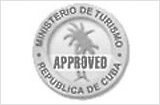Cuban Music
Cuban music holds immense popularity worldwide and is easily recognizable. It encompasses a wide array of genres and styles, with a rich and captivating history influenced by African, Spanish, American, Latin-American, and European musical traditions.
Dance plays a significant role in Cuban music's allure, with "the son" at the heart of it all. Originating in late 1800s Cuba, this distinctive Creole dance style bears strong African and Spanish roots, serving as the foundation for countless Cuban dance styles and rhythms that emerged over time.
One of the most renowned dances stemming from "the son" is salsa, also known as Casino. Cuban Salsa blends elements of Son Montuno and draws inspiration from various Afro-Cuban folkloric dances like Mambo, Danzon, Guaguanco, and more. Dancing Casino, or salsa, is deeply ingrained in Cuban social culture, while Latin Americans hold it in high regard as a cultural and social activity. The style gained popularity in Cuba during the late 1950s when musicians such as Klimax and Los Van Van introduced faster and more vibrant musical arrangements.
In the 1960s, the nueva trova movement gained traction, with young intellectuals in Cuba using music as a platform to reflect changing political and social ideologies. Notable artists like Pablo Milanes and Silvio Rodriguez propelled the movement to household recognition.
A pivotal moment in Cuban musical culture occurred in 1997 with the formation of the Buena Vista Social Club. This iconic recording united some of Cuba's most celebrated musicians, including Compay Segundo and Ibrahim Ferrer, and sold millions of copies globally.
Cuba is also renowned for other dance and music forms, such as the bolero, chachacha, danzon, guaracha, and rumba. These styles contribute to the vibrant tapestry of Cuban cultural heritage.
Cuban Literature
Cuban literature has a rich history that traces back to as early as 1605 with the poem titled “Espejo de Paciencia” by Silvestre de Balboa. This epic poem recounted the struggle between a French pirate and a Spanish bishop, and while it may now be valued more for its historical significance, it was highly esteemed during its time.
However, it was in the early 19th century that Cuban literature truly came into its own, developing its own unique style of writing. The turning point for Cuban literature is often attributed to the lyrical and poetic works of Jose Maria Heredia (1803-1839), particularly his famous poems “Oda al Niagara” and “En el teocalli de Chobula”, which are considered the starting point of Spanish Romanticism in Cuban literature.
During this period, the major literary works in Cuba focused on themes such as slavery, racial segregation in Creole society, and colonialism. Notable writers during this time included Cirilo Villaverde (1812-1894) and Gertrudis Gomez de Avellaneda (1814-1873). Villaverde's “Cecilia Valdes” is widely regarded as a significant piece in Cuban literature.
Undoubtedly, the most renowned and influential writer in Cuban literature is Jose Marti (1853-1895). Marti, who worked as a journalist, essayist, political theorist, poet, and revolutionary philosopher, incorporated themes of democracy, freedom, and liberty into his works. He wrote a diverse range of pieces, including children's magazines, poems, novels, letters, and essays. Among these, his children's book “The Golden Age” (La Edad de Oro) stands out as the most famous and widely read.
Marti's book of poetry, “Ismaelillo” was dedicated to his son and serves as a guide to parenthood and fatherhood. The poems in this collection express the anguish Marti felt during his exile and separation from his son.
Another notable work by Marti is “Versos Sencilios”, which showcases his profound love for Cuba, his admiration for nature, and his strong convictions about injustice and the importance of friendship. Many of his most acclaimed poems can be found in this collection, as Marti wrote about his personal feelings and experiences in a deeply heartfelt manner. These works have solidified Marti's reputation as one of the major contributors to the Spanish American Modernismo literary movement.
During the 1920s and 30s, the Afrocubanismo movement played a significant role in shaping Cuba's literature and culture. The literature of this period was distinctly Cuban, blending the African roots of the island's people with their unique creativity and style. Nicolas Guillen, Cuba's National Poet, achieved great fame as a writer during this movement. His book of son poetry, “Motivos de Son”, which was published in 1930, is widely regarded as his finest work.
A literary technique called lo real maravilloso, or magical realism, was utilized to delve into the fantastical aspects of Latin American culture and history. Alejo Carpentier is recognized as one of the pioneers of this technique. His 1949 work “The Kingdom of This World” (El Reino de Este Mundo), which explores the 18th century Haitian revolution with Afro-Cuban influences, stands as a testament to his innovative approach. Carpentier's other works, such as “El Siglo de las Luces” and “Los Pasos Perdidos”, are highly acclaimed and hold a significant place in Latin American literature.
Jose Lezama Lima caused quite a scandal in post-Revolution Cuba with his novel “Paradiso”. The book delved into the theme of homosexual relationships and sparked controversy at the time. Lima, primarily known as a poet, played a major role in the criollismo movement of Cuban literature during the 1940s and 50s.
Testimonial literature, a genre rooted in Cuba, finds its master in Miguel Barnet. His masterpiece “Biografia de un Cimarron”, published in 1966, showcases the essence of this genre.
There have been numerous noteworthy literary figures throughout Cuba's history. Guillermo Cabrera Infante, born in 1929, offers a vivid portrayal of Havana's nightlife during the dictatorship of Batista in his work “Tres Tristes Tigres”. Dulce Maria Loynaz, despite having published only the novel “Jardin”, is widely considered one of the pioneers of the magical realism genre.
Cuba's Painting
Cuba has been home to a number of talented and famous artists throughout its history, particularly in the time period from 1900 to 1975. Of course, as our Cuba cultural travel guides can tell you, the history of Cuban painting extends back much farther.
During the 18th and early 19th centuries, Cuban art was dominated by religious paintings and portraits. This time period saw the rise of artists such as Juan del Rio (1748-?), Vincente Escobar (1762-1834), and Jose Nicolas de la Escalera (1734-1833).
In 1818, a world renowned French painter by the name of Jean Baptiste Vermay (1786-1833) was appointed as the first director of the new Academy of Fine Arts " San Alejandro" which influenced all artistry production in Cuba until the 1920's.
During the 19th century, primary trends in academic style landscape painting were realism, commonly seen in works by artists such as Guillermo Collazo (1850-1896) and Valentin Sanz Carta (1849-1896), and romanticism such as that displayed in the works of Jose Joaquin Tejada (1867-1943) and Esteban Chartrand (1840-1883).
Two of Cuba’s most renowned painters, Armando Menocal (1863-1942) and Leopoldo Romanach (1862-1951) served the Academy of San Alejandro for half a century, contributing to emerging painting styles and mentoring new generations of painters.
In the early 20th century, Cuban artists began to embrace European modernism and the avant-garde artistic movement began to take off, as much of the art from this time period seen in Cuba’s museum tours reflects.
During this period, Cuba saw the creation of famous works such as1938’s Los Guajiros- Eduardo Abela’s (1889-1965) work idealizing the notion of both the Cuban countryside and the peasant. Works such as Gitana Tropical, created by Victor Manuel (1867-1969) showcase modernism as a theme in Cuban art, with this work being widely renowned as the beginning of the trend. This period also saw the rise to fame of artists such as Amelia Pelaez (1896-1968), Fidelio Ponce de Leon (1895-1949), Carlos Enriquez (1900-1957), and Marcelo Pogolotti (1902-1988).
The art of the 1940’s and 50’s saw Cuban artists working towards expressing their unique Cuban identities and art became much more individualistic. It was this era that saw the rise of the man who is still largely considered Cuba’s most popular and famed painter, Wifredo Lam (1902-1982).
Lam considered the famed artist Pablo Picasso among his closest friends and was introduced to the style of art known as surrealism from Andre Breton. For his own style, Lam seamlessly blended African masks, surrealism, and synthetic Cubism to create a unique but quintessentially Cuban vision.
Another famed artist of this time period is Rene Portocarrero (19112-1985), whose colorful paintings make use of imagery with a Cuban baroque theme. Mariano Rodriguez also belongs to this generation, and his early Gallos series, produced during the 1940’s showcases the influences of popular Mexican muralists of the time.
The Cuban Revolution helped promote visual arts throughout Cuba. As a result, the premiere National Arts School was established in 1962. 1976 saw the founding of the Higher Institute of Art, while 1984 saw the establishment of the famous Havana Art Biennial.
Pop art also made its way to the island in the 1960’s, with Raul Martinez (1927-1995) gaining fame for his colorful portraits of Cuban leaders and political figures like Che Guevara, and Jose Marti.
The 1970’s gave birth to the works of a few famous artists, including Manuel Mendive (b. 1944), Flavio Garciandia (b.1954), Nelson Dominguez (b. 1947), and Tomas Sanchez (b. 1948).
In the 1980’s, conceptual art started to emerge throughout Cuba, and numerous generations of Cuban artists started to come together. This led to the creation of numerous alternative groups, such as ArteCalle, Hacer, Grupo Provisiona, 4X4, Sano y Sabroso, and Pure.
Strain between the institutional system and many artists created friction near the later part of the decade, however, with many artists either permanently or temporarily making an exodus to places like the United States, Mexico, and Venezuala.
In the 1990’s, performance art became a popular means of artistic expression, with names such as Tania Bruguera (b. 1968) and Carlos Garaicoa (b. 1967) becoming a big part of the art scene.
Art from this decade highlights the unique and diverse views of Cubans regarding both The Revolution as well as the impact of the embargo enacted by the United States. Metaphors are commonly used to highlight the isolation of Cuba as well as incipient racism, shortages, and the tragedy surrounding the rafters or balseros.
This period has seen the rise of artists such as Abel Barroso (b. 1971), Alexix Leyva, or Kcho (b. 1970) and Tonel, or Antonio Eligio Fernandez (b. 1958).
Cuban Cuisine
Cuban cuisine is a vibrant fusion of African, Spanish, Indigenous, and various other cultures. With such diverse influences, it's no wonder that Cuban dishes are bursting with flavor. One of the most celebrated dishes in Cuba is ajiaco, a hearty stew made with your choice of pork, beef, or poultry and a medley of root vegetables. But that's just the beginning of the culinary journey in Cuba.
Fried green plantains, known as tostones, are a popular snack and side dish that adds a delightful crunch to any meal. Lechon, a succulent roast pork dish, is a true showstopper. And don't miss out on moros y cristianos, a classic combination of black beans and rice that will leave you craving for more.
Other must-try delicacies in Cuba include mouthwatering roast chicken, tantalizing tamales, and a flavorful ground beef dish called picadillo a la habanera, which features a savory tomato sauce. The secret to these delectable dishes lies in the skillful use of light sauces that enhance the natural flavors of the meats. Key spices like bay leaves, cumin, oregano, onion, and garlic are vital ingredients that infuse Cuban cuisine with its distinct character.
As you explore Cuban cuisine, you'll discover that each bite is a celebration of the country's rich cultural heritage. From the diverse influences to the robust flavors, Cuban cuisine is a true culinary delight that will transport your taste buds to the colorful streets of Havana.
Cuban Sports
Since the Revolution, the Cuban government has made significant investments in the promotion of sports across the country. In 1961, just two years after the triumph of the Revolution, the National Institute of Sport, Physical Education, and Recreation (INDER) was established as the governing body for all sports and recreational activities in Cuba. One of the notable achievements in Cuban sports history was the hosting of the Pan-American Games in 1991, where Cuba emerged as the top-performing nation with an impressive total of 265 medals.
Baseball holds a special place in Cuban culture and is considered the national sport, capturing the passion of most Cubans. Its roots can be traced back even before the Spanish conquest, as the Taino Indians played a similar game called "batos". The sport was officially introduced to the island in the 1860s by Cubans who studied in the United States and American sailors who visited the country. Since then, it has rapidly gained popularity across the entire nation.
The national baseball team of Cuba is widely regarded as one of the best in Latin America and holds its own on the world stage. Each province in the country has its own baseball team, with Havana City boasting two teams and the municipality of Isla de la Juventud having another. In total, there are 16 teams in the national baseball league. The baseball season kicks off in early autumn and culminates with national finals in May. The format of the finals is similar to the basketball league in the United States, where the top teams from the Eastern and Western conferences compete in a best-of-seven series.
Cuba's prowess in boxing is unparalleled, with the nation achieving remarkable success on the international stage. From the 1968 Olympic Games in Mexico City to Beijing 2008, Cuban boxers have participated in nine Olympic tournaments, securing an impressive total of 55 medals – 32 gold, 15 silver, and 8 bronze. No other country boasts such accomplishments. Cuba also proudly claims the distinction of having two three-time Olympic Champions in boxing: Teofilo Stevenson (1972, 1976, and 1980) and Felix Savon (1992, 1996, and 2000). Cuba's passion for boxing is evident in the number of athletes pursuing the sport. Of the 99,000 athletes in Cuba, 19,000 are boxers, with 81 of them competing at the Olympic level. However, due to the country's commitment to amateur sports, Cuban boxers do not participate in lucrative professional boxing matches.
Track and field sports have also played a significant role in Cuba's sports history. The country's first Olympic success in this discipline came in 1964 in Tokyo when Enrique Figuerola won a silver medal in the Men's 100-meter sprint. Cuba continued to produce exceptional athletes in track and field, such as Alberto Juantorena Danger, who dominated the sport in the 1970s, setting two world records and winning gold in the 400m and 800m races at the 1976 Montreal Olympics. In the 1990s, notable names in Cuban track and field included Iván Pedroso, Ana Fidelia Quiroz, and Javier Sotomayor.
In addition to baseball, boxing, and track and field, basketball, volleyball, and soccer are also highly popular sports in Cuba.
US Cuba Legal Travel
In terms of visiting Cuba, legal travel from the USA has been all but impossible for over half a century.
Right now, however, a rare alteration in travel regulations made by former US President Barack Obama offers US citizens the opportunity to go to Cuba under the General License for Educational Activities, Support for the Cuban People, Professional Research, among others.
After the publication of the new updates to the Cuban Assets Control Regulations (31 CFR Part 515) on February 6, 2025, and July 14, 2025, all 12 categories of legal Cuba travel remain unaffected; except for the Individual People-to-people General License for Cuba travel which has been ended (the Group People-to-people General License) has been re-authorized though.
The future of travel from the US to Cuba is uncertain, and right now, US travelers still have the chance to go to Cuba legally for Professional Research, Support for the Cuban People, Professional Meetings, Religious Activities, and other venues.
Cuba Themed Tours
If you’ve got an idea of which style of trip will suit you best, take a look at our different trip themes below, as there’s something to suit everyone. Not only are there themed tours to fit any budget and interest, each Authentic Cuba Travel® experience immerses you in the authentic Cuba so hard to explore while just staying in full packed beach resorts.
Festival Tours
Our festival tours give travelers VIP access to all venues and happenings of Cuba’s famous international events such as the Havana Jazz Festival, Book Fair, Ballet Festival and others.
Study Tours
Through peer to peer interaction, our Cuba Study Tours® transcend ordinary tourism by immersing American students in the local culture, history, politics, music and contemporary arts.
Cultural Tours
Cuba Pathfinder® is your gateway to discover the unique Cuban cultural heritage, a set of traditions & memories not showcased in museums but much alive & thriving.
Architecture Tours
An architectural passage through Cuba’s best preserved colonial cities and unique architectural heritage, our architecture tours visit all UNESCO World Heritage Sites in Cuba.
Photography Tours
Capturing stirring pictures of authentic Cuban destinations it is not the only mission of our photography tours. Capture the essence of the Cuban culture and the kindness of its people.
Educational Tours
Our educational tours represents a great opportunity for K-12 teachers, university & college professors to explore Cuba’s education system while exploring colonial cities, towns and villages.
Nature Tours
An odyssey into Cuba's tropical paradise, our nature & bird watching tours gain access to the most pristine natural sites, from UNESCO Biosphere Reserves to National Parks.
Jewish Tours
A journey into the Jewish history in Cuba, our tours will strengthen the ties between Cuban Jewish communities and North American Jews. All while visiting 4 UNESCO World Heritage Sites!
Sports Tours
What sets our sports tours apart are the private exchanges with players, coaches & staff as well as sports journalists & personalities. Then you have best seats at the games!
CUBA TOUR FINDER
Select your authentic Cuba trip from over 70 Cuba tours in seconds. Sort by departure date, price, destination and even Cuba travel theme.
QUICK CUBA TOUR FINDERList of Cuba Tours 2026
-
Tour Name
Tour Dates
Cost
-
Havana Film Festival
Havana, Vinales
Dec 8- Dec 15, 2025
$2,899 Book Now
-
Real Cuba Tour 12
Havana, Las Terrazas, Vinales
Dec 26- Jan 2, 2026
$2,799 Book Now
-
Cuba Engage Tour 12
Havana, Bay of Pigs, Trinidad
Dec 26- Jan 2, 2026
$2,799 Book Now
-
Cuba Education Tour 9
Havana, Cienfuegos, Trinidad
Dec 26- Jan 2, 2026
$2,599 Book Now
-
Cuba Education Tour 10
Havana, Bay of Pigs, Santa Clara
Dec 26- Jan 2, 2026
$2,599 Book Now
-
Cuba Education Tour 11
Havana, Santiago de Cuba
Dec 26- Jan 2, 2026
$2,799 Book Now
-
Bird Watching Tour
Havana, Zapata, Trinidad
Dec 26- Jan 2, 2026
$2,599 Book Now
-
Cuba Architecture II
Havana, Cienfuegos, Trinidad
Dec 26- Jan 2, 2026
$2,799 Book Now
-
Cuba Art Explorer IV
Havana, Las Terrazas
Dec 26- Jan 2, 2026
$2,799 Book Now
-
Photography Tour IV
Havana, Vinales, Trinidad
Dec 26- Jan 2, 2026
$2,729 Book Now
-
Jewish Heritage Tour
Havana, Cienfuegos, Trinidad
Dec 26- Jan 2, 2026
$2,899 Book Now
-
Family Discovery Tour
Havana, Cienfuegos, Trinidad
Dec 26- Jan 2, 2026
$2,699 Book Now
-
Real Cuba Tour 1
Havana, Las Terrazas, Vinales
Jan 10- Jan 17, 2026
$2,599 Book Now
-
Cuba Engage Tour 1
Havana, Bay of Pigs, Trinidad
Jan 10- Jan 17, 2026
$2,599 Book Now
-
Cuba Jazz Festival
Havana, Cienfuegos, Trinidad
Jan 25- Feb 2, 2026
$3,099 Book Now
-
Santiago Jazz Festival
Santiago de Cuba
Jan 25- Feb 1, 2026
$2,899 Book Now
-
Havana Jazz Festival
Havana, Vinales
Jan 28- Feb 2, 2026
$2,499 Book Now
-
Havana Book Fair
Havana, Cienfuegos, Trinidad
Feb 13- Feb 20, 2026
$2,799 Book Now
-
Real Cuba Tour 2
Havana, Las Terrazas, Vinales
Feb 7- Feb 14, 2026
$2,599 Book Now
-
Cuba Engage Tour 2
Havana, Bay of Pigs, Trinidad
Feb 7- Feb 14, 2026
$2,599 Book Now
-
Habano Cigar Festival
Havana, Vinales
Feb 21- Feb 28, 2026
$8,999 Book Now
-
Cuba Education Tour 1
Havana, Cienfuegos, Trinidad
Feb 21- Feb 28, 2026
$2,599 Book Now
-
Cuba Education Tour 2
Havana, Cienfuegos, Trinidad
Feb 28- Mar 7, 2026
$2,599 Book Now
-
Cuba Al Natural
Havana, Zapata, Trinidad
Mar 7- Mar 18, 2026
$2,859 Book Now
-
Cuba Business Tour 1
Havana, Matanzas, Varadero
Mar 7- Mar 14, 2026
$2,599 Book Now
-
Healthcare Cuba Tour 1
Havana, Cienfuegos, Trinidad
Mar 7- Mar 14, 2026
$2,599 Book Now
-
Real Cuba Tour 3
Havana, Las Terrazas, Vinales
Mar 7- Mar 14, 2026
$2,599 Book Now
-
Cuba Engage Tour 3
Havana, Bay of Pigs, Trinidad
Mar 7- Mar 14, 2026
$2,599 Book Now
-
Cuba Art Explorer I
Havana, Vinales
Mar 7- Mar 14, 2026
$2,599 Book Now
-
Bird Watching Tour
Havana, Zapata, Trinidad
Mar 7- Mar 14, 2026
$2,599 Book Now
-
Cuba Education Tour 3
Havana, Cienfuegos, Trinidad
Mar 7- Mar 14, 2026
$2,599 Book Now
-
Cuba Education Tour 4
Havana, Vinales
Mar 14- Mar 21, 2026
$2,599 Book Now
-
Photography Tour I
Havana, Vinales, Trinidad
Apr 4- Apr 11, 2026
$2,629 Book Now
-
The Nature of Cuba
Havana, Vinales, Trinidad
Apr 4- Apr 13, 2026
$2,799 Book Now
-
Real Cuba Tour 4
Havana, Las Terrazas, Vinales
Apr 4- Apr 11, 2026
$2,599 Book Now
-
Cuba Engage Tour 4
Havana, Bay of Pigs, Trinidad
Apr 4- Apr 11, 2026
$2,599 Book Now
-
4 Biosphere Reserves
Rosario, Zapata, Buenavista
May 1- May 10, 2026
$2,999 Book Now
-
Real Cuba Tour 5
Havana, Las Terrazas, Vinales
May 9- May 16, 2026
$2,599 Book Now
-
Cuba Engage Tour 5
Havana, Bay of Pigs, Trinidad
May 9- May 16, 2026
$2,599 Book Now
-
Photography Tour II
Havana, Vinales, Trinidad
Jun 6- Jun 13, 2026
$2,629 Book Now
-
Cuba Art Explorer II
Havana, Cienfuegos, Trinidad
Jun 6- Jun 13, 2026
$2,599 Book Now
-
Cuba Education Tour 5
Havana, Cienfuegos, Trinidad
Jun 6- Jun 13, 2026
$2,599 Book Now
-
Real Cuba Tour 6
Havana, Las Terrazas, Vinales
Jun 6- Jun 13, 2026
$2,599 Book Now
-
Cuba Engage Tour 6
Havana, Bay of Pigs, Trinidad
Jun 6- Jun 13, 2026
$2,599 Book Now
-
Cuba Fire Festival
Havana, Santiago de Cuba
Jul 2- Jul 9, 2026
$2,799 Book Now
-
Real Cuba Tour 7
Havana, Las Terrazas, Vinales
Jul 4- Jul 11, 2026
$2,599 Book Now
-
Cuba Engage Tour 7
Havana, Bay of Pigs, Trinidad
Jul 4- Jul 11, 2026
$2,599 Book Now
-
Cuba Business Tour 2
Havana, Matanzas, Varadero
Jul 4- Jul 11, 2026
$2,599 Book Now
-
Healthcare Cuba Tour 2
Havana, Cienfuegos, Trinidad
Jul 4- Jul 11, 2026
$2,599 Book Now
-
Cuba Education Tour 6
Havana, Santiago de Cuba
Jul 4- Jul 11, 2026
$2,799 Book Now
-
Cuba Education Tour 7
Havana, Las Terrazas & Vinales
Jul 11- Jul 18, 2026
$2,599 Book Now
-
Jews of Cuba Travel
Havana, Santa Clara, Cienfuegos
Aug 6- Aug 13, 2026
$2,799 Book Now
-
Real Cuba Tour 8
Havana, Las Terrazas, Vinales
Aug 8- Aug 15, 2026
$2,599 Book Now
-
Cuba Engage Tour 8
Havana, Bay of Pigs, Trinidad
Aug 8- Aug 15, 2026
$2,599 Book Now
-
Photography Tour III
Havana, Vinales, Trinidad
Aug 8- Aug 15, 2026
$2,629 Book Now
-
Cuba Education Tour 8
Havana, Cienfuegos, Trinidad
Aug 8- Aug 15, 2026
$2,599 Book Now
-
Cuba Art Explorer III
Havana, Vinales
Aug 8- Aug 15, 2026
$2,599 Book Now
-
Cuba Legal Travel
Havana, Vinales
Aug 8- Aug 15, 2026
$2,799 Book Now
-
Cuba Architecture I
Havana, Cienfuegos, Trinidad
Aug 8- Aug 15, 2026
$2,599 Book Now
-
Seven Cities II
Havana, Santiago de Cuba
Aug 8- Aug 19, 2026
$3,329 Book Now
-
Real Cuba Tour 9
Havana, Las Terrazas, Vinales
Sep 5- Sep 12, 2026
$2,599 Book Now
-
Cuba Engage Tour 9
Havana, Bay of Pigs, Trinidad
Sep 5- Sep 12, 2026
$2,599 Book Now
-
Baseball Tour
Havana, Cienfuegos, Trinidad
Sep 5- Sep 12, 2026
$2,999 Book Now
-
African Heritage
Havana, Las Terrazas, Vinales
Oct 3- Oct 9, 2026
$2,699 Book Now
-
Real Cuba Tour 10
Havana, Las Terrazas, Vinales
Oct 3- Oct 10, 2026
$2,599 Book Now
-
Cuba Engage Tour 10
Havana, Bay of Pigs, Trinidad
Oct 3- Oct 10, 2026
$2,599 Book Now
-
Dance Cuba Tour
Havana, Las Terrazas
Oct 3- Oct 10, 2026
$2,599 Book Now
-
Performing Arts Tour
Havana, Cienfuegos, Trinidad
Oct 3- Oct 10, 2026
$2,599 Book Now
-
Cuba Ballet Festival
Havana, Vinales
Oct 31- Nov 7, 2026
$2,999 Book Now
-
Jo Jazz Havana
Havana, Las Terrazas, Vinales
Nov 4- Nov 11, 2026
$2,799 Book Now
-
Seven Cities I
Havana, Santiago de Cuba
Nov 5- Nov 16, 2026
$3,329 Book Now
-
Cuba Nature Tour
Havana, Vinales, Trinidad
Nov 6- Nov 15, 2026
$2,799 Book Now
-
Art & Fashion Festival
Havana, Cienfuegos, Trinidad
Nov 6- Nov 13, 2026
$2,699 Book Now
-
Real Cuba Tour 11
Havana, Las Terrazas, Vinales
Nov 7- Nov 14, 2026
$2,599 Book Now
-
Cuba Engage Tour 11
Havana, Bay of Pigs, Trinidad
Nov 7- Nov 14, 2026
$2,599 Book Now
-
Cuba Business Tour 3
Havana, Matanzas, Varadero
Nov 7- Nov 14, 2026
$2,599 Book Now
-
Healthcare Cuba Tour 3
Havana, Cienfuegos, Trinidad
Nov 7- Nov 14, 2026
$2,599 Book Now
-
Havana Art Biennial
Havana, Vinales
Dec 11- Dec 18, 2027
$2,799 Book Now
SUBSCRIBE
Sign up for email updates from Authentic Cuba Travel®. Our monthly newsletters are full of information on Cuba Study Tours®, Cuba Education Tours, Cuba Cultural Tours, Cuba Architecture Travel, Cuba Festival Travel, Cuba Nature & Bird Watching Travel & Sport Tours. Free Familiarization (FAM) Cuba Tours for educators. Get discounts from Authentic Cuba Travel®!
NewsletterMemberships & Affiliations
Bella Travel Group Ltd. (Federal Corporation number: 765324-7) owns and operates the following registered trademarks: Authentic Cuba Travel® is a trademark registered at the Canadian Intellectual Property Office (CIPO), Registration No. TMA975677 | Cuba Pathfinder® is a trademark registered at the Canadian Intellectual Property Office (CIPO), Registration No. TMA997988 | Cuba Pathfinder® is a trademark registered at the United States Patent and Trademark Office (USPTO), Registration No. 5498353 | Cuba Study Tours, Make Cuba Your Classroom® is a trademark registered at the United States Patent and Trademark Office (USPTO), Registration No. 5833051.

 1-877-280-2054 (North America)
1-877-280-2054 (North America) 647-351-8191
(Worldwide)
647-351-8191
(Worldwide)
 647-351-8191
(Worldwide)
647-351-8191
(Worldwide)
















